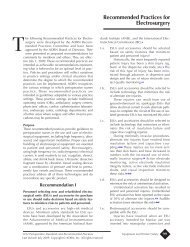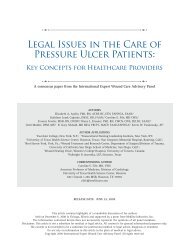2009 CAUTI guidelines - Centers for Disease Control and Prevention
2009 CAUTI guidelines - Centers for Disease Control and Prevention
2009 CAUTI guidelines - Centers for Disease Control and Prevention
You also want an ePaper? Increase the reach of your titles
YUMPU automatically turns print PDFs into web optimized ePapers that Google loves.
appropriate. (Category IB)2C.5.b. Further research is needed on the use of antiseptic solutions vs. sterile water or saline<strong>for</strong> periurethral cleaning prior to catheter insertion. (No recommendation/unresolved issue)2C.6. Changing indwelling catheters or drainage bags at routine, fixed intervals is notrecommended. Rather, catheters <strong>and</strong> drainage bags should be changed based on clinicalindications such as infection, obstruction, or when the closed system is compromised.(Category II)2C.7.a. Use a sterile, single-use packet of lubricant jelly <strong>for</strong> catheter insertion. (Category IB)2C.7.b. Routine use of antiseptic lubricants is not necessary. (Category II)2C.8. Further research is needed on the use of bacterial interference to prevent UTI in patientsrequiring chronic urinary catheterization. (No recommendation/unresolved issue)2C.9. Further research is needed on optimal cleaning <strong>and</strong> storage methods <strong>for</strong> catheters used<strong>for</strong> clean intermittent catheterization. (No recommendation/unresolved issue)2C.10.a. Clamping indwelling catheters prior to removal is not necessary. (Category II)2C.10.b. Insert catheters only <strong>for</strong> appropriate indications, <strong>and</strong> leave in place only as long asneeded. (Category IB)2C.10.c. For operative patients who have an indication <strong>for</strong> an indwelling catheter, remove thecatheter as soon as possible postoperatively, preferably within 24 hours, unless there areappropriate indications <strong>for</strong> continued use. (Category IB)2C.11.a. Consider using a portable ultrasound device to assess urine volume in patientsundergoing intermittent catheterization to assess urine volume <strong>and</strong> reduce unnecessarycatheter insertions. (Category II)2C.11.b. Further research is needed on the use of a portable ultrasound device to evaluate <strong>for</strong>obstruction in patients with indwelling catheters <strong>and</strong> low urine output. (Norecommendation/unresolved issue)Q2D. What are the risks <strong>and</strong> benefits associated with different systemsinterventions?The available data examined the following systems interventions:1. Infection control/quality improvement programs (multifaceted)2. Catheter reminders3. Bacteriologic monitoring4. H<strong>and</strong> hygiene5. Patient placement6. Catheter team versus self-catheterization7. Feedback8. Nurse-directed catheter removalWe considered <strong>CAUTI</strong> outcomes, duration of catheterization, recatheterization, <strong>and</strong>transmission of pathogens when weighing the risks <strong>and</strong> benefits of different systemsinterventions. The evidence <strong>for</strong> this question consists of 1 RCT 259 <strong>and</strong> 19 observational45
















